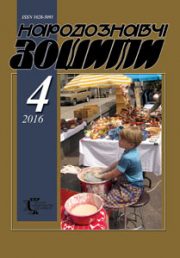The Ethnology Notebooks. 2021. № 3 (159), 524—542
DOI https://doi.org/10.15407/nz2021.03.524
RADOVYCH Roman
- ORCID ID: http://orcid.org/0000-0002-1900-8948
- Doctor of Sciences in History, Senior Researcher
- of the Institute of Ethnology
- of the National Academy of Sciences of Ukraine,
- in the Department of Historical Ethnology,
- Svobody Avenue 15, 79000,
- Lviv, Ukraine
- Contacts: e-mail: radovychroman@gmail.com
Abstract. Finding out the specifics of houses, their structural elements which existed in a certain period in certain ethnographic regions (and districts) for the ethnological science of today is extremely urgent. The author aims to clarify the features of traditional housing construction (planning, construction techniques, specifics of roofs, window openings, interiors, etc.), which characterize the houses of the third quarter of the XIX century on the territory of the former Podillia province.
The object of research is traditional construction, and the subject is folk housing.
The methodological basis of the study is the principle of historicism in combination with elements of structural and functional analysis and the use of basic methods of ethnological science: retrospective, typological, complex and analysis, historical reconstruction and more.
The study area covers all counties of the former Podillia region, the chronological boundaries of the study — the third quarter of the nineteenth century; the upper chronological limit is 1873. The work is based on the collection «Materials for the study of Podillia region in statistical and economic terms», the content of which is formed by statistical and economic information collected by correspondents (1871—1872) in some counties of Podillia region.
Keywords: Podillia region, housing, construction equipment, planning, windows, roof.
Received 20.04.2021
REFERENCES
- (1873). Materials for the study of the Podolsk province in statistical and economic relations Kamenets-Podolsk: Printing House of the Provincial Administration [in Russian].
- Hratsianska, N.N., Listova, N.M., & Tokarev, S.A. (1968). Introduction. Typology of people’s dwellings in countries of foreign Europe. Types of rural dwellings in countries of foreign Europe (Pp. 3—11). Moscow: Nauka [In Russian].
- Zelenin, D.K. (1916). Description of the manuscripts of the scientific archive of the Imperial Russian Geographical Society (Issue 3, pp. 989—1279). Petrograd: Printing house A.V. Orlov [in Russian].
- Zawadzki, W. (1869). Images of Red Ruthenia (With drawings by J. Kossak). Poznan: Published by Jan Zupanski [in Polish].
- Vovk, Hv. (1995).Ethnographic features of the Ukrainian people. In Vovk, Hv. Studies on Ukrainian ethnography and anthropology (Pp. 39—218). Kyiv: Art [in Ukrainian].
- Rusov, M.A. (1902). Settlements and buildings of the peasants of the Poltava region. Collection of the Kharkiv Historical and Philological Society (Vol. 13, pp. 72—120). Kharkiv: Printing house [in Russian].
- Кosmina, T.V. (1980). Rural habitation of Podillya (end of 19—20 centuries): Historical and ethnographic research. Kyiv: Naukova dumka [in Ukrainian].
- Svydnytsky, A. (1985). Luboratski. In Svydnytsky, A. Novel, stories, essays (Pp. 27—210). Kyiv: Naukova Dumka [in Ukrainian].
- Koltativ, S. (1993). Culture Vilhovechan. Construction in the village Vilhovets over the Dniester long time ago and now. Chronicle of Borshchivschyna: Historical and Local Studies Collection (Issue ІV, pp. 57—66). Borschiv: Dzherelo [in Ukrainian].
- Chubynsky, P.P. (1877). Little Ruthenians Southwestern Region: housing, utensils, farm buildings and implements. Proceedings of the ethnographic and statistical expedition to the West Ruthenian Territory, equipped by the Russian Geographical Society of the South-West Department (Vol. 7, issue 2, pp. 339—606). SPb [in Russian].
- Svyryda, R. (2009). Traditions of folk building. Shevchenko’s land (Pp. 350—363). Kyiv [in Ukrainian].
- Radovych, R. (2017). Pokuttia traditional accommodation: technique and technology of wall construction (19th — first half of 20th centuries). Plisnensky antiquities, 2, 27—61 [in Ukrainian].
- Radovych, R. (2020). Traditional dwelling in Bukovyna Podillia (second half of the 19th — early 20th centuries) based on materials from Khotyn district, Chernivtsi region. The Ethnology Notebooks, 2, 277—292 [In Ukrainian].
- Radovych, R. (2012). Traditional housing in the north of ethnographic Volhynia: features and Volyn-Polissya parallels (second half of the XIX — beginning of the XX century). The Ethnology Notebooks, 2, 201—217 [in Ukrainian].
- Klymovych, Yu., & Chubynska, K. (1969). Historical and statistical descriptions of parishes as an ethnographic source. Folk art and ethnography, 3, 41—45 [in Ukrainian].
- Radovych, R. (2010). Traditional housing of Ukrainians in the southern part of Podillya in the second half of the 19th — beginning of the 20th centuries: structural and technological aspect (based on materials of the Khmelnytsky region). Bulletin of the University of Lviv. Series Historical (Issue 45, pp. 437—462). Lviv: Lviv National University of I. Franko [in Ukrainian].
- Radovych, R. (2017). Polissya dweling: cultural and genetic origins and evolutionary processes. Lviv: Institute of Ethnology of the National Academy of Sciences of Ukraine [in Ukrainian].
- Rappoport, P. A. (1975). Old Ruthenian dwelling. Archeology of the USSR: SAI (Issue E1—32). Leningrad: Nauka [in Russian].
- (1858). Life of the Malorussian peasant (Mostly in the Poltava province). Ethnographic collection (Pp. 19—46). St. Petersburg [in Russian].
- Radovych, R. (1989). Report on the scientific expedition to Opillya. In The Archive of LMNAP. F. Materials of expeditions. Exp. ЗВ—92 [in Ukrainian].
- Padalka, L.V. (1905). What did the population of Poltava region say about their old life? Proceedings of the Poltava Scientific Archival Commission (Issue 2, pp. 22—29). Poltava [in Russian].
- Rusov, A.A. (1899). Description of the Chernigov region (Vol. 2). Chernigov: Printing House of the Provincial Zemstvo [in Russian].
- Kaydl, R.F. (2000). Hutsuls: their lives, customs and folk tales. Chernivtsi: Molodyy budivelnyk [in Ukrainian].
- Koltativ, S. (1994). Culture Vilhovechan. Home furnishings in the village of Vilhovets on the Dniester. Chronicle of Borshchivschyna: Historical and Local Studies Collection (Issue V, pp. 42—55). Borschiv: Dzherelo [In Ukrainian].







